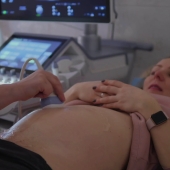Genetic screening is performing tests on a pregnant woman to help determine if the baby she is carrying may have Down syndrome or other birth defects. All pregnant women should be offered genetic screening. It helps parents prepare for a child with special needs.
What are the genetic screens and how are they performed?
Currently the three most common tests are the first trimester screen, the quad screen and the sequential screen. The first trimester screen is usually done between 10 and 13 weeks and involves both an ultrasound and a blood draw, usually taken from your finger. The quad screen is typically done between 15 and 20 weeks, this involves a blood draw taken from your arm.The sequential screen involves two parts. The first part involves an ultrasound between 10 and 13 weeks and a blood draw from your finger. This is followed by a second blood draw done between 15 and 20 weeks.
When can I expect the results?
The results from all the tests take about three to five days. With the sequential screen you will get a preliminary and final result. A low risk result reassures the family their baby is not affected with Down syndrome, 99.97 percent of the time. A high risk result identifies the pregnancies where further testing and evalution is recommended. In addition to screening for Down syndrome, these tests can help identify babies who may have other chromosomal defects or other structural defects like Spina Bifida. If any of the blood tests identify the pregnancy as high risk for birth anomalies, further screening will be recommended, followed by a higher level ultrasound and in some cases amniocentesis.
What are the risks of genetic screenings?
With the blood draw and ultrasound there is no risk. When the amniocentesis is performed by a specialist, the risk is minimal.
- 154 views













